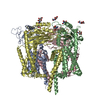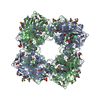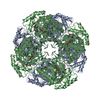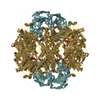+ Open data
Open data
- Basic information
Basic information
| Entry | Database: PDB / ID: 7d7e | |||||||||
|---|---|---|---|---|---|---|---|---|---|---|
| Title | Structure of PKD1L3-CTD/PKD2L1 in apo state | |||||||||
 Components Components |
| |||||||||
 Keywords Keywords |  TRANSPORT PROTEIN / Heterotetrameric TRP channel / TRANSPORT PROTEIN / Heterotetrameric TRP channel /  Calcium / Calcium /  Primary cilia / PKD Primary cilia / PKD | |||||||||
| Function / homology |  Function and homology information Function and homology informationdetection of chemical stimulus involved in sensory perception of sour taste / detection of chemical stimulus involved in sensory perception of taste / sensory perception of sour taste / response to water /  calcium-activated potassium channel activity / cellular response to pH / detection of mechanical stimulus / calcium-activated potassium channel activity / cellular response to pH / detection of mechanical stimulus /  cation channel complex / muscle alpha-actinin binding / cellular response to acidic pH ...detection of chemical stimulus involved in sensory perception of sour taste / detection of chemical stimulus involved in sensory perception of taste / sensory perception of sour taste / response to water / cation channel complex / muscle alpha-actinin binding / cellular response to acidic pH ...detection of chemical stimulus involved in sensory perception of sour taste / detection of chemical stimulus involved in sensory perception of taste / sensory perception of sour taste / response to water /  calcium-activated potassium channel activity / cellular response to pH / detection of mechanical stimulus / calcium-activated potassium channel activity / cellular response to pH / detection of mechanical stimulus /  cation channel complex / muscle alpha-actinin binding / cellular response to acidic pH / cation channel complex / muscle alpha-actinin binding / cellular response to acidic pH /  sodium channel activity / non-motile cilium / calcium-activated cation channel activity / inorganic cation transmembrane transport / ciliary membrane / smoothened signaling pathway / alpha-actinin binding / monoatomic cation transport / sodium ion transmembrane transport / monoatomic cation channel activity / potassium ion transmembrane transport / sodium channel activity / non-motile cilium / calcium-activated cation channel activity / inorganic cation transmembrane transport / ciliary membrane / smoothened signaling pathway / alpha-actinin binding / monoatomic cation transport / sodium ion transmembrane transport / monoatomic cation channel activity / potassium ion transmembrane transport /  calcium channel complex / calcium channel complex /  cytoskeletal protein binding / protein tetramerization / cytoskeletal protein binding / protein tetramerization /  calcium channel activity / calcium channel activity /  actin cytoskeleton / cytoplasmic vesicle / actin cytoskeleton / cytoplasmic vesicle /  carbohydrate binding / protein homotetramerization / transmembrane transporter binding / carbohydrate binding / protein homotetramerization / transmembrane transporter binding /  receptor complex / intracellular membrane-bounded organelle / receptor complex / intracellular membrane-bounded organelle /  calcium ion binding / calcium ion binding /  endoplasmic reticulum / endoplasmic reticulum /  membrane / identical protein binding / membrane / identical protein binding /  plasma membrane / plasma membrane /  cytosol cytosolSimilarity search - Function | |||||||||
| Biological species |   Mus musculus (house mouse) Mus musculus (house mouse) | |||||||||
| Method |  ELECTRON MICROSCOPY / ELECTRON MICROSCOPY /  single particle reconstruction / single particle reconstruction /  cryo EM / Resolution: 3.4 Å cryo EM / Resolution: 3.4 Å | |||||||||
 Authors Authors | Su, Q. / Chen, M. / Li, B. / Wang, Y. / Jing, D. / Zhan, X. / Yu, Y. / Shi, Y. | |||||||||
| Funding support |  China, 2items China, 2items
| |||||||||
 Citation Citation |  Journal: Nat Commun / Year: 2021 Journal: Nat Commun / Year: 2021Title: Structural basis for Ca activation of the heteromeric PKD1L3/PKD2L1 channel. Authors: Qiang Su / Mengying Chen / Yan Wang / Bin Li / Dan Jing / Xiechao Zhan / Yong Yu / Yigong Shi /   Abstract: The heteromeric complex between PKD1L3, a member of the polycystic kidney disease (PKD) protein family, and PKD2L1, also known as TRPP2 or TRPP3, has been a prototype for mechanistic characterization ...The heteromeric complex between PKD1L3, a member of the polycystic kidney disease (PKD) protein family, and PKD2L1, also known as TRPP2 or TRPP3, has been a prototype for mechanistic characterization of heterotetrametric TRP-like channels. Here we show that a truncated PKD1L3/PKD2L1 complex with the C-terminal TRP-fold fragment of PKD1L3 retains both Ca and acid-induced channel activities. Cryo-EM structures of this core heterocomplex with or without supplemented Ca were determined at resolutions of 3.1 Å and 3.4 Å, respectively. The heterotetramer, with a pseudo-symmetric TRP architecture of 1:3 stoichiometry, has an asymmetric selectivity filter (SF) guarded by Lys2069 from PKD1L3 and Asp523 from the three PKD2L1 subunits. Ca-entrance to the SF vestibule is accompanied by a swing motion of Lys2069 on PKD1L3. The S6 of PKD1L3 is pushed inward by the S4-S5 linker of the nearby PKD2L1 (PKD2L1-III), resulting in an elongated intracellular gate which seals the pore domain. Comparison of the apo and Ca-loaded complexes unveils an unprecedented Ca binding site in the extracellular cleft of the voltage-sensing domain (VSD) of PKD2L1-III, but not the other three VSDs. Structure-guided mutagenic studies support this unconventional site to be responsible for Ca-induced channel activation through an allosteric mechanism. | |||||||||
| History |
|
- Structure visualization
Structure visualization
| Movie |
 Movie viewer Movie viewer |
|---|---|
| Structure viewer | Molecule:  Molmil Molmil Jmol/JSmol Jmol/JSmol |
- Downloads & links
Downloads & links
- Download
Download
| PDBx/mmCIF format |  7d7e.cif.gz 7d7e.cif.gz | 346.7 KB | Display |  PDBx/mmCIF format PDBx/mmCIF format |
|---|---|---|---|---|
| PDB format |  pdb7d7e.ent.gz pdb7d7e.ent.gz | 286.2 KB | Display |  PDB format PDB format |
| PDBx/mmJSON format |  7d7e.json.gz 7d7e.json.gz | Tree view |  PDBx/mmJSON format PDBx/mmJSON format | |
| Others |  Other downloads Other downloads |
-Validation report
| Arichive directory |  https://data.pdbj.org/pub/pdb/validation_reports/d7/7d7e https://data.pdbj.org/pub/pdb/validation_reports/d7/7d7e ftp://data.pdbj.org/pub/pdb/validation_reports/d7/7d7e ftp://data.pdbj.org/pub/pdb/validation_reports/d7/7d7e | HTTPS FTP |
|---|
-Related structure data
| Related structure data |  30606MC  7d7fC M: map data used to model this data C: citing same article ( |
|---|---|
| Similar structure data |
- Links
Links
- Assembly
Assembly
| Deposited unit | 
|
|---|---|
| 1 |
|
- Components
Components
| #1: Protein | Mass: 69234.734 Da / Num. of mol.: 3 Source method: isolated from a genetically manipulated source Source: (gene. exp.)   Mus musculus (house mouse) / Gene: Pkd2l1, Trpp3 / Production host: Mus musculus (house mouse) / Gene: Pkd2l1, Trpp3 / Production host:   Homo sapiens (human) / References: UniProt: A2A259 Homo sapiens (human) / References: UniProt: A2A259#2: Protein | |  / PC1-like 3 protein / Polycystin-1L3 / PC1-like 3 protein / Polycystin-1L3Mass: 62541.914 Da / Num. of mol.: 1 Source method: isolated from a genetically manipulated source Source: (gene. exp.)   Mus musculus (house mouse) / Gene: Pkd1l3, 71B10 / Production host: Mus musculus (house mouse) / Gene: Pkd1l3, 71B10 / Production host:   Homo sapiens (human) / References: UniProt: Q2EG98 Homo sapiens (human) / References: UniProt: Q2EG98#3: Sugar | ChemComp-NAG /  N-Acetylglucosamine N-Acetylglucosamine#4: Chemical | Has ligand of interest | N | |
|---|
-Experimental details
-Experiment
| Experiment | Method:  ELECTRON MICROSCOPY ELECTRON MICROSCOPY |
|---|---|
| EM experiment | Aggregation state: PARTICLE / 3D reconstruction method:  single particle reconstruction single particle reconstruction |
- Sample preparation
Sample preparation
| Component | Name: Heterotetrameric TRP channel of PKD1L3/PKD2L1 complex / Type: COMPLEX / Entity ID: #1-#2 / Source: RECOMBINANT |
|---|---|
| Source (natural) | Organism:   Mus musculus (house mouse) Mus musculus (house mouse) |
| Source (recombinant) | Organism:   Homo sapiens (human) Homo sapiens (human) |
| Buffer solution | pH: 7.5 |
| Specimen | Embedding applied: NO / Shadowing applied: NO / Staining applied : NO / Vitrification applied : NO / Vitrification applied : YES : YES |
Vitrification | Cryogen name: ETHANE |
- Electron microscopy imaging
Electron microscopy imaging
| Experimental equipment |  Model: Titan Krios / Image courtesy: FEI Company |
|---|---|
| Microscopy | Model: FEI TITAN KRIOS |
| Electron gun | Electron source : :  FIELD EMISSION GUN / Accelerating voltage: 300 kV / Illumination mode: FLOOD BEAM FIELD EMISSION GUN / Accelerating voltage: 300 kV / Illumination mode: FLOOD BEAM |
| Electron lens | Mode: BRIGHT FIELD Bright-field microscopy Bright-field microscopy |
| Image recording | Electron dose: 50 e/Å2 / Film or detector model: GATAN K3 BIOQUANTUM (6k x 4k) |
- Processing
Processing
| Software | Name: PHENIX / Version: 1.17.1_3660: / Classification: refinement | ||||||||||||||||||||||||
|---|---|---|---|---|---|---|---|---|---|---|---|---|---|---|---|---|---|---|---|---|---|---|---|---|---|
CTF correction | Type: NONE | ||||||||||||||||||||||||
3D reconstruction | Resolution: 3.4 Å / Resolution method: FSC 0.143 CUT-OFF / Num. of particles: 549716 / Symmetry type: POINT | ||||||||||||||||||||||||
| Refinement | Highest resolution: 3.4 Å | ||||||||||||||||||||||||
| Refine LS restraints |
|
 Movie
Movie Controller
Controller











 PDBj
PDBj









